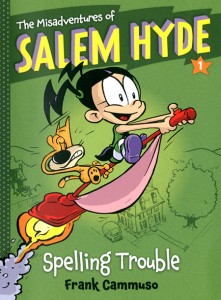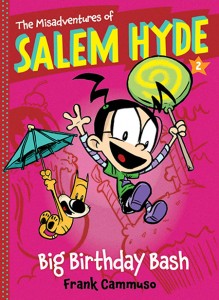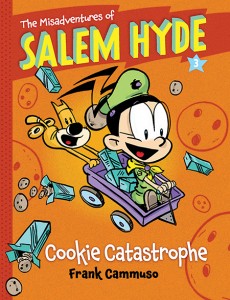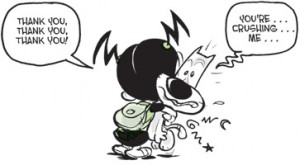Welcome to Using Graphic Novels in Education, an ongoing feature from CBLDF that is designed to allay confusion around the content of graphic novels and to help parents and teachers raise readers. In this column, we examine graphic novels, including those that have been targeted by censors, and provide teaching and discussion suggestions for the use of such books in classrooms.
This post takes a closer look at The Misadventures of Salem Hyde, by Frank Cammuso.
“Ever since Salem Hyde arrived at our school, strange things have been happening.”
— Mr. Fink, The Misadventures of Salem Hyde: Spelling Trouble
The Misadventures of Salem Hyde is a wonderful series about a strong-willed, spunky, impulsive young witch living in a non-witch community, who has a slight problem: Her spells tend to backfire. However, with the help of Whammy, her companion cat, she slowly deals with her “spelling” issues while boldly facing her nemesis Shelly and her teacher Mr. Fink (who “dislikes all kinds of kids but especially Salem”). The Misadventures of Salem Hyde received starred reviews from Kirkus Reviews and Publishers Weekly, and was named one of the Top 10 graphic novels of 2013 by The School Library Journal. These books contain fun-filled adventures and wordplay that make them an awesome read for kids of all ages (even though it is geared for 7- to 10-year-olds).
OVERVIEW
The Misadventures of Salem Hyde series is as empowering as it is fun. Through her misadventures, Salem has to learn how to curb her impulsivity, she has to come to grips with a mean, selfish girl named Shelly, and she has to somehow stay out of Mr. Fink’s hair, as he has no tolerance for Salem. And she has to do all this while trying to control her “spelling” because her spells never quite come out right. To do this, Salem’s parents (non-witches) seek the advice of witch Aunt Martha, who recommends Salem get an “animal companion,” While Salem insists on a unicorn, she ends up with an “unoriginal” cat named Percival J. Whamsford III, M.A.C. — or Whammy, for short. Whammy helps guide the well meaning but impulsive young witch as she navigates the challenges of school (and scouting). To their mutual surprise, they become fast friends.
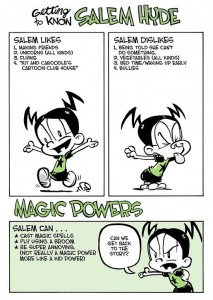 What makes these books so empowering is the way author/illustrator Frank Cammuso respectfully yet playfully incorporates concepts of diversity and special needs (in this case the backfiring spells of an impulsive young witch) in a way that makes us all laugh and embrace Salem’s weaknesses — maybe because there’s a little bit of Salem in all of us. Best of all, he shows how a spunky, independent young girl can embrace whom she is with the help of her friends.
What makes these books so empowering is the way author/illustrator Frank Cammuso respectfully yet playfully incorporates concepts of diversity and special needs (in this case the backfiring spells of an impulsive young witch) in a way that makes us all laugh and embrace Salem’s weaknesses — maybe because there’s a little bit of Salem in all of us. Best of all, he shows how a spunky, independent young girl can embrace whom she is with the help of her friends.
The playfulness in this series is achieved through Cammuso’s wonderful use of image, color, and text. The wordplay, the wonderful faces and expressions (inspired by and much like Calvin and Hobbes), and even Cammuso’s limited use of color all contribute to the fun of this series. While the books are predominantly black, white, and grayscale, each has a one color to add to the playfulness of the illustrations. The first book uses a new-leaf green, the second a bright pink, and the third a bold orange.
Furthermore, the combination of text, art and page/panel design teaches young readers about character development. Cammuso brilliantly lays out Salem, Shelly, Whammy, and Mr. Fink’s characters so we can “get to know” them. In one page (with three distinct panels), we learn what they like, what they don’t like, and what magic (and non-magic) powers they have. Cammuso also relays Whammy and Salem’s moods brilliantly with over-the-top mannerisms and expressions. Not only do their eyes, mouths, ears, and Salem’s bat-wing-like lightning bolt hair bulge, squint, rotate, and move in all sorts of ways and manners, the range of their expressions is absolutely breathtaking.
 To help us appreciate and recognize Salem and Whammy’s breadth of expressions, Cammuso will take a page and devote it to a montage of expressions, often to show us how exasperated or shocked Salem and/or Whammy are with each other. (Keep reading for how you might use these montages for lessons on character development and language use.)
To help us appreciate and recognize Salem and Whammy’s breadth of expressions, Cammuso will take a page and devote it to a montage of expressions, often to show us how exasperated or shocked Salem and/or Whammy are with each other. (Keep reading for how you might use these montages for lessons on character development and language use.)
This series is a wonderful addition to any elementary school classroom and library for several reasons. First, Cammuso, an Eisner-nominated cartoonist, unabashedly has fun with language and wordplay. He writes with a penchant for puns, homonyms, and alliteration, and we can’t help but be swept up in the fun. We see, we hear, and we laugh at how words can be twisted. And while we love some of the fun twists and wordplay, we understand how they can lead to misunderstanding. These books instill a love of wordplay and a strong appreciation for language and word choice, empowering all kinds of language learners in the classroom. Second, Cammuso provides wonderful lessons on character development. Third, the series deals with themes of diversity, individuality, and tolerance in a different, refreshing manner.
Finally, we have Cammuso’s messages that ever so subtly and humorously teach us to recognize good intentions and true friendship and the power they have on us all. Through Salem and Whammy readers also learn:
- that sometimes, the best way to solve problems is to bone up on weaknesses and sometimes, to slow down.
- that everything in life (and in Salem’s case — magic) has a cost.
- that even if kids (or animal companions) are different, we shouldn’t jump to conclusions about them; instead, they need to be embraced and respected for who and what they are.
The Misadventures of Salem Hyde: Spelling Trouble introduces us to Salem, her friends, her family, and her “spelling” trouble. The book opens with Shelly, Salem’s nasty nemesis, who is studying for the spelling bee. Salem, however, isn’t worried because she’s a good speller! And wham, on the first page we see what fun there will be with the story and wordplay. While Shelly’s concerned about a typical school spelling bee, Salem’s thinking about her skill with magical spells. We soon learn, however, that our cute bespectacled young witch is wonderfully confident, though not particularly skilled with her “spelling.”
 Salem immediately gets into trouble, and her non-magical parents ask Aunt Martha, the witch in the family, for advice. Aunt Martha’s advice: Get Salem an animal companion. Salem’s not so enthusiastic about this and insists the only animal companion she’ll accept would be a unicorn. Much to Salem’s disappointment, she gets a cat (“…how unoriginal”) named Percival J. Whamsford III, M.A.C. — or Whammy, for short. And while their relationship is rocky at the outset (they are SO different from each other), Whammy helps Salem learn to be a better witch and a better friend — all while cleaning up her mess from the spelling bee, where homophones (literally) run amok.
Salem immediately gets into trouble, and her non-magical parents ask Aunt Martha, the witch in the family, for advice. Aunt Martha’s advice: Get Salem an animal companion. Salem’s not so enthusiastic about this and insists the only animal companion she’ll accept would be a unicorn. Much to Salem’s disappointment, she gets a cat (“…how unoriginal”) named Percival J. Whamsford III, M.A.C. — or Whammy, for short. And while their relationship is rocky at the outset (they are SO different from each other), Whammy helps Salem learn to be a better witch and a better friend — all while cleaning up her mess from the spelling bee, where homophones (literally) run amok.
In this 95-page book of fun, adventure, and wordplay, not only do we meet Salem and her friends, we are exposed to the fun-filled world of homophones; to the misadventures of Moby Dick as they might be told to frightened, young, impressionable kids who don’t do sad; and to the whacky brilliance of Cammuso’s Abbot and Costello’s “Who’s on First” spoof.
The Misadventures of Salem Hyde: Big Birthday Bash is about the joys and perils of gift giving as Salem and Shelly compete to give Edgar the best birthday present ever. With Whammy’s version of “The Gift of the Magi,” Salem learns that gift giving is “not about the cost. What counts is the thought.” In this second volume, Shelly is as mean as ever and as Salem continues to face her challenges, Cammuso keeps the jokes, puns, and similes coming as Salem’s birthday gift/spell misfires yet again.
 The Misadventures of Salem Hyde: Cookie Catastrophe is about the world of scouting. In this volume, Salem joins the Squirrel Scouts. She must abide by the rules, learn the Squirrel Scout motto, and meet the challenge of selling the most cookies. She must then survive the camping trip she’s won for her troop while dealing with their resentment of her having picked camping in the woods over a shopping trip to New York City. To battle her fellow scouts’ anger and to cope with the challenges of camping, Salem of course leans on her magic with hilarious consequences.
The Misadventures of Salem Hyde: Cookie Catastrophe is about the world of scouting. In this volume, Salem joins the Squirrel Scouts. She must abide by the rules, learn the Squirrel Scout motto, and meet the challenge of selling the most cookies. She must then survive the camping trip she’s won for her troop while dealing with their resentment of her having picked camping in the woods over a shopping trip to New York City. To battle her fellow scouts’ anger and to cope with the challenges of camping, Salem of course leans on her magic with hilarious consequences.
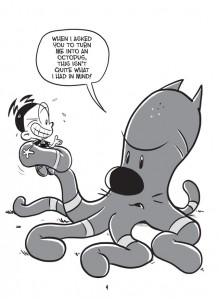 TEACHING/DISCUSSION SUGGESTIONS:
TEACHING/DISCUSSION SUGGESTIONS:
Plot, Themes, and Values Related
- Have students talk about each of the stories and what they can learn from them.
- Compare these stories toBill Watterson’s Calvin and Hobbes. Discuss how Calvin and Salem are similar/different and how Hobbes and Whammy are similar/different.
- Whether read before Christmas, Valentines Day, or any class birthday, discuss the challenges of gift giving. You may want do discuss: What is the best gift you ever gave? What are the challenges of finding “the best gift ever” and do you prefer making or buying such gifts?
- Discuss how Salem might feel as the only witch in the school. What challenges does she face as a result? Why does Mr. Fink seem to resent her so much? What advice might your students give to Salem to help her with her “spelling” and to help her being so different?
- Discuss how and why Salem and Whammy become friends. Have students explore why neither Salem nor Whammy wanted to be a team in the beginning and why they ended up friends at the end.
- Discuss Salem and Shelly’s relationship. Have students explore why Shelly might be mean to Salem and have them evaluate how Salem deals with Shelly and her challenges. Is this the best way to deal with bullies? Why or why not?
 Critical Reading and Making Inferences
Critical Reading and Making Inferences
- Discuss why the Salem Hyde series uses the word “Misadventures” in its title.
- Search and discuss the advice and lessons Whammy gives Salem. Here are some examples:
- Spelling Trouble:
p. 56: “There’s nothing more terrifying than a kitty-loving two-year-old.”
p. 62: “When you chase something, it runs away. Be patient and it will come to you.”
p. 64: “…spell casting and spelling are very similar. One letter out of place can change the whole meaning.”
P. 51: For teachers’ eyes only, while not a necessarily true witticism, it does bring a smile: “75% of teaching is making up stuff.”
- Big Birthday Bash:
p. 6: “Growing things takes a lot of magic. Everything has a cost.”
p. 40: When choosing gifts, “It’s not about the cost. What counts is the thought.”
- Cookie Catastrophe:
p. 9: “What if everyone gave up when things got difficult?”
p. 10: “You never accomplish anything when you give up.”
p. 44: “Shelly’s neighborhood?! This neighborhood doesn’t belong to her!”
- Spelling Trouble:
- When evaluating Whammy’s advice to Salem, you may also want to turn this into a writing exercise and have kids work individually, in pairs, or in groups to create their own truths and insights.
- When reading these books, Cammuso makes wonderful inferences you may want to discuss with your students. For example:
- Spelling Trouble:
 pp. 35-35: On their “flight” test Whammy says, “I think I found a design flaw…You need a longer extension cord” Discuss what this means and what that design flaw is, based on the text and images. You may also want to discuss what makes this is so funny.
pp. 35-35: On their “flight” test Whammy says, “I think I found a design flaw…You need a longer extension cord” Discuss what this means and what that design flaw is, based on the text and images. You may also want to discuss what makes this is so funny. - Big Birthday Bash:
p. 13: Salem is sure she and Whammy have made it home before Dad. Discuss why Salem says, “I wouldn’t worry about him…” (getting home so soon).
p. 23: Discuss why Salem is mad at Edgar for giving her invitation to his birthday to Shelly. - Cookie Catastrophe:
p. 14: We are introduced to the Squirrel Scout laws and motto. Discuss what might have gone into deciding what laws should be followed by Squirrel Scouts.
p. 24: As Salem leaves to sell cookies, Whammy advises her, “Remember, you aren’t selling cookies, you’re selling squirrel scouts.” Discuss why this might be helpful.
pp. 30-31: Salem makes “exact copies” of herself to try to sell more cookies. Why is this a mistake?
- Spelling Trouble:
Language, Literature, and Language Usage
- There is wonderful wordplay everywhere you look in this series. You may want to begin with Cammuso’s choice of names: Salem Hyde, Mr. Fink, and Whammy.
- Have wonderful fun discovering the puns, homophones, idioms and play on words. You may want students to work on teams to search for these gems and then create some of their own examples. Here are some good ones:
- Spelling Trouble:
- Homophones:
- Bear/bear/bare
- Boar/bore
- Wail/whale
- Knight/night
- Mousse/moose
- Bald/bawled
- Homophones:
- Spelling Trouble:
- Puns/wordplay
- Spelling (words)/spelling (casting spells)
- p. 9: “Mrs. Fossil, the dinosaur!”
- p. 15: Whammy’s …“really cleaning up!”
- p. 16: Whammy’s “…NOT a scaredy-cat!”
- p. 66: Whammy calls Aunt Martha because “It’s like I said, I’m stuck in a tight situation.”
- Big Birthday Bash
- Puns/wordplay
- p. 11 “big trouble”
- p. 16: Shelly tells Salem, “You’ve been schooled.”
- p. 50: After casting a spell, Salem and Whammy’s cart is running out of control into a display, “Price Smash”
- p. 27: Similes: “I’m focused like a laser.
- Puns/wordplay
- Cookie Catastrophe
- Puns/wordplay
- p. 44: Whammy (the cat) says, “Nothing will stop us from our dogged quest.”
- p. 23: The wonderful cookie names: Dutch Doozies, Mini Minty Molasses Macaroons, Krispy Krunchy Crusty Clusters. Have students come up with their own names for cookies (or soft drinks, or other food items) they might sell.
- Throughout this book there is a lot of alliteration. Have students search for examples and then make up their own.
- Puns/wordplay
- In Spelling Trouble, pp. 29-31: Whammy informs Salem that she’ll be taking the W.H.A.T. (Winifred Hubble Aptitude Trials). Have students discuss why people make up and enjoy acronyms. Have students search for examples of other acronyms. Then, brainstorm the use of acronyms and what acronyms they might use for assorted types of tests or evaluations.
- In Spelling Trouble, pp. 29-31: After Whammy describes the W.H.A.T., Cammuso has wonderful fun with this as he creates his own version of the famous Abbot and Costello routine “Who’s on First.” (Keep reading for a link for the original skit.) Discuss the play on language and why this routine is both classic and funny.
- In the first two volumes, Cammuso plays with two different classic stories, Moby Dick (by Herman Melville) and “The Gift of the Magi” (by O. Henry). Have students (individually, in groups, or as a class) think of their favorite stories — have them select one and create (write and draw or act/tell) their own version.
- Shelly and Salem are rivals. Analyze how they talk/insult each other. Do they communicate and use words differently? How and why? Discuss the power of words – how they hurt each other. Finally, brainstorm better ways these ‘friends’ may more effectively communicate.
- In Cookie Catastrophe, pp. 18-19: Whammy quizzes Salem on the Squirrel Scout motto. Why might she be having trouble remembering it? You may want to brainstorm ways Salem might better learn and memorize the motto. Discuss why “Critters aren’t Quitters” might have been chosen. Then brainstorm a class motto.
 Modes of Storytelling and Visual Literacy
Modes of Storytelling and Visual Literacy
In graphic novels, images are used to relay messages with and without accompanying text, adding additional dimension to the story. In The Misadventures of Salem Hyde, Cammuso brilliantly weaves story and background with image, and emotions and insights through text, image, and design. Reading The Misadventures of Salem Hyde together with your students allows you to analyze, discuss, and learn how Cammuso uses page and panels, text, and images to relay complex messages. For example:
- Mr. Cammuso is a master of facial expressions. Have students search for the ranges of Whammy and Salem’s moods as shown through their expressions and have them find as many synonyms as they can to describe each mood. (NOTE: In Spelling Trouble (p. 47), Cammuso devotes a page to a montage of Salem’s expressions, and in Cookie Catastrophe (pp. 7 and 33), he devotes a montage to Whammy’s — you may want to use these instead of students searching.)
- As Cammuso uses cartoon-like characters, evaluate how he uses each character’s features to help describe them. For example, Salem has bat-winged shaped ponytails, Whammy has a large head. Discuss what these features reflect about their character and continue doing this with Shelly and Mr. Fink and Whammy’s BF (Cookie Catastrophe).
- Discuss Caruso’s use of balloon design to help tell the story. Analyze how the text balloon shapes, sizes and designs are used to relay different character moods.
- Frank Cammuso also plays a lot with the borders of his panels. Discuss why certain panel formats change, when they change, and evaluate what Cammuso is trying to convey to the reader.
 Suggested Prose, Graphic Novel and Poetry Pairings
Suggested Prose, Graphic Novel and Poetry Pairings
For greater discussion on literary style, related themes, similar characters, and/or content, here are some book suggestions you may want to read and pair with The Misadventures of Salem Hyde:
- Knights of the Lunch Table by Frank Cammuso: A fun-filled series with a wonderful twist on the Arthurian legend. This series is about Artie King and his life at Camelot Middle School as he faces Principal Dagger and bullies big bad Joe and The Horde.
- Max Hamm Fairy Tale Detective by Frank Cammuso: A collection of classic children’s stories (especially “the stuff your parents never told you about when you were a kid”) that are retold in a 1930-1940’s Hollywood-type town.
- Otto’s Backwards Day and Otto’s Orange Day by Frank Cammuso: A story about Otto and his robot sidekick Toot and their wonderful adventures.
- Calvin and Hobbesby Bill Watterson: Collections of comic strips about a rambunctious six-year-old with a vivid imagination and sharp intellect who is wonderfully creative and impulsive, and much like Salem.
- Amelia Rules! by Jimmy Gownley: About the life of Amelia, another strong-willed girl who must deal with her own frenemy, Rhonda (much like Salem deals with Shelly).
- Freckle Juice, Tales of a Fourth Grade Nothing, Are You There God? It’s Me, Margaret,and Otherwise Known as Sheila the Great: Just a few of the books Judy Blame wrote about the honest and humorous trails of growing up.
- A Book of Homophones by Gene Barretta
- How Much Can a Bare Bear Bear? by Brian P. Cleary: A picture book about homophones.
- Babymouse by Jennifer L. Holm and Matthew Holm: An award-winning graphic novel series that showcases the trials and tribulations of elementary school students and teachers, as seen through the eyes of Babymouse, as spunky, lovable mouse who wrestles with popularity, quirky lockers, competition, and more.
- Squish by Jennifer and Matthew Holm — another graphic novel series by this awesome duo. Compare and contrast their use of language, page design, and themes in each series.
- Diary of a Wimpy Kid by Jeff Kinney — a series about a boy and his struggles in middle school.
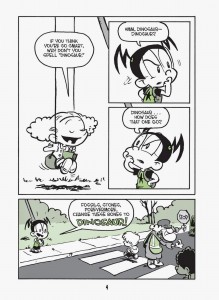 Common Core State Standards (CCSS):
Common Core State Standards (CCSS):
While this book is written for young readers and suggested for elementary school classrooms, it can be incorporated into language arts and content-area classes for a variety of grades. I therefore will be using the Common Core Anchor Standards for College and Career Readiness for Reading, Writing, and Speaking and Listening. Reading The Misadventures of Salem Hyde and incorporating the teaching suggestions above promotes critical thinking and its graphic novel format provides verbal and visual story telling across subject areas while addressing multi-modal teaching. Here’s a more detailed look:
- Knowledge of Language: Apply knowledge of language to understand how language functions in different contexts, to make effective choices for meaning or style, to comprehend more fully when reading or listening.
- Vocabulary Acquisition and Use: Determine or clarify the meaning of unknown and multiple-meaning words and phrases by using context clues, analyzing meaningful word parts, and consulting general and specialized reference materials; demonstrate understanding of figurative language, word relationships, and nuances in word meaning; acquire and use accurately a range of general academic and domain-specific words and phrases sufficient for reading, writing, speaking and listening at the college and career readiness level.
- Key ideas and details: Reading closely to determine what the texts says explicitly and making logical inferences from it; citing specific textual evidence when writing or speaking to support conclusions drawn from the text; determining central ideas or themes and analyzing their development; summarizing the key supporting details and ideas; analyzing how and why individuals, events, or ideas develop and interact over the course of the text.
- Craft and structure: Interpreting words and phrases as they are used in a text, including determining technical, connotative, and figurative meanings and analyzing how specific word choices shape meaning or tone; analyzing the structure of texts, including how specific sentences, paragraphs and larger portions of the text relate to each other and the whole; Assessing how point of view or purpose shapes the content and style of a text.
- Integration of knowledge and ideas: Integrate and evaluate content presented in diverse media and formats, including visually…as well as in words; delineate and evaluate the argument and specific claims in a text, including the validity of the reasoning as well as the relevance and sufficiency of the evidence; analyze how two or more texts address similar themes or topics in order to build knowledge or to compare the approaches the authors take
- Range of reading and level of text complexity: Read and comprehend complex literary and informational texts independently and proficiently
- Comprehension and collaboration: Prepare for and participate effectively in a range of conversations and collaborations with diverse partners, building on others’ ideas and expressing their own clearly and persuasively; integrate and evaluate information presented in diverse media and formats, including visually, quantitatively and orally; evaluate a speaker’s point of view, reasoning, and use of evidence and rhetoric.
ADDITIONAL RESOURCES:
- The Misadventures of Salem Hyde teaching suggestions from Abrams and Amulet Books (found within their “Amulet Books Graphic Novel Teaching Guide): http://www.abramsbooks.com/academic/GraphicNovels_TeachingGuide.pdf
- Salem Hyde’s Twelve Days of Christmas by Frank Cammuso: An online comic gem you can find here: http://salemhyde.tumblr.com/
- For a Sesame Street version of O. Henry’s “The Gift of the Magi,” featuring Ernie and Bert, visit: http://youtu.be/o2VFgHGKzx4
- For a Disney version of “The Gift of the Magi,” featuring Mickey and Minnie, visit: http://youtu.be/98JHQ1Y1FVA
- Abbot and Costello’s “Who’s on First” sketch: http://youtu.be/kTcRRaXV-fg
- Moby Dick animated cartoon (in four parts): https://www.youtube.com/playlist?list=PLABB6C846372EAF5F
- If you’re interested in your students performing a kid-friendly version of “The Gift of the Magi,” here’s a script adapted for Scholastic’s magazine Scope by Mack Lewis, art by Linda Wingerter: https://www.ocps.net/lc/southwest/hdp/Documents/2014 Summer Assignments/B. Gift of the Magi Story.pdf
- Google books offers a free preview of Book 3 Cookie Catastrophe here: https://books.google.com/books?id=K95FBAAAQBAJ&pg=PA56&lpg=PA56&dq=the+misadventures+of+salem+hyde&source=bl&ots=3nVJO4eUEZ&sig=qyDZG6s4CBdZBsbGiHQcw0tCNRc&hl=en&sa=X&ei=QeamVMzKC42GyATgmoGgAw&ved=0CCgQ6AEwAjgU – v=onepage&q=the misadventures of salem hyd
Meryl Jaffe, PhD teaches visual literacy and critical reading at Johns Hopkins University Center for Talented Youth OnLine Division and is the author of Raising a Reader! and Using Content-Area Graphic Texts for Learning. She used to encourage the “classics” to the exclusion comics, but with her kids’ intervention, Meryl has become an avid graphic novel fan. She now incorporates them in her work, believing that the educational process must reflect the imagination and intellectual flexibility it hopes to nurture. In this monthly feature, Meryl and CBLDF hope to empower educators and encourage an ongoing dialogue promoting kids’ right to read while utilizing the rich educational opportunities graphic novels have to offer. Please continue the dialogue with your own comments, teaching, reading, or discussion ideas at meryl.jaffe@cbldf.org and please visit Dr. Jaffe at http://www.departingthe text.blogspot.com.
Help support CBLDF’s important First Amendment work in 2015 by visiting the Rewards Zone, making a donation, or becoming a member of CBLDF!
All images (c) Frank Cammuso.
